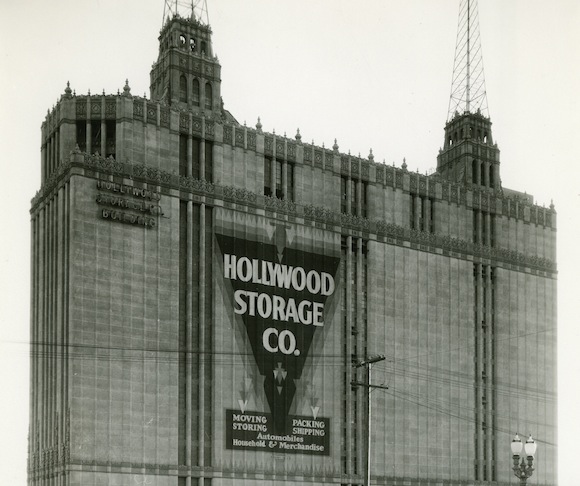UNITED STATES—An intriguing fact: modern self-storage was born right smack in Hollywood. Built in 1925 during silent movies’ golden age, the 14-story Hollywood Storage Co. was the tallest building in Hollywood.
Located at Highland Avenue and Santa Monica Boulevard, Hollywood Storage Co. was also a radio station, and topped by two radio towers for the station in the pent-house, but primarily used for storage for the massive influx of people coming to a city poised for huge expansion. To reap the opportunities in the area, they needed a place to stash their stuff while getting settled.
The behemoth building was surrounded by farms and ranches, orange groves, pineapple orchards, Mexican nopal cactus, and a burgeoning silent movie industry including nearby Charlie Chaplain’s studio and Paramount Pictures. The building stood there for 14 years until Bekins purchased it in 1939.
John Trosko, owner of OrganizingLA, a Los Angeles-based professional organizing business, states in a blog post that “It was big and iconic, almost like an advertisement. I see it as freedom and mobility. Put your stuff here and you won’t have to worry about it—we’ll take care of it … The building helped facilitate people’s dreams to be mobile.”
Au contraire, a place to stow what we will charitably call stuff can be a ball and chain.
From day one in my own family’s quest to rid ourselves of the storage locker and staunch the monthly bleed of rental payments, there was a tremendous pull to elsewhere: to be at home, visiting, drinking coffee or day tripping toCarmel. At the beginning of this venture, I prayed that we could overcome the lure of comfortable routine and that the spell of the “stuff” over us could be broken. Toward that end, I burned a few matches to release that dense energy—discreetly, so not to provoke Mom’s ridicule for Angeleno rituals. (Sage is not readily available in the New Age deprived Watsonville.) We needed all the help we could get, supernatural and otherwise.
In the first place, my mother was reluctant to come, and when we got inside the musty dusty locker, she was reluctant to stay. “You spend just so much time out here and you can’t take it any more.”
As I say, we were nevertheless lucky to be here on this mission. Facing the cumulus of the past was always tough on my mom and tough on my dad. His immediate family had been dead for years and the remaining personal objects and mementos had an overwhelming pull on his heartstrings, unexpressed but undeniable. Also, everything, inside the anonymous spic-and-span sterility of a modern self-storage locker complex was imbued by the unmistakable scent of eau de thrift store. Dad was never an opinionated man, but if there was one thing he found repulsive it was the smell of thrift-stores, and he steered clear of them.
It is easy—too easy—to get mesmerized by all the things there gathered, to lose oneself in the dizzying cross section of time represented, and meander in the byways of memory. I was struck by all the clothes. Two cardboard closets and mounds of the stuff: T-shirts and sweatshirts my mom used to wear, and flare-bottom pant suits from the 70s. Something had happened, just like something had happened to the supersized U.S. of A., and the person who had once lived with two dresses a every week, alternated every couple of days, during the Depression, had come a long way.
Quickly she filled the back of my car with clothes for Goodwill and I stashed some books somewhat surreptitiously. (I did not for one minute discount that Mom, packrat that she was, could still shut us down). My dad had collected gambling books—tons of them—“Surefire craps” and “How to Win At 21.” And my Mom collected diet books, which is of interest to me as the author of a diet book myself. Early in this venture, I vowed that we would pool all the diet books—a half century trove of American dieting history and fads whose sheer quantity will be a cause for future hilarity and whose historical value is not to be overlooked.
But a funny thing happened. I carried the box designated for diet books over to the “large” locker, to be a gathering place as we uncovered more diet books, and on the second day of our endeavor, it got engulfed and misplaced in the blob of stuff. Never saw it again. . .
To be continued…
Humorist Grady Miller is the author of “Lighten Up Now: The Grady Diet,” now in paperback on Amazon. He can be reached at grady.miller@canyon-news.com.






